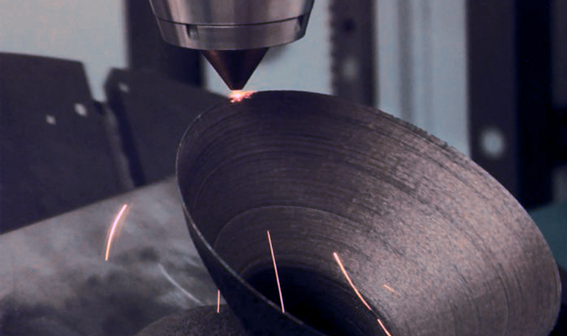Direct Energy Deposition
Process description
direct energy deposition is a combination of welding and additive manufacturing technologies. a high power heat source is used to deposit a feed stock directly onto the bed (typically welding it onto a sacrificial print bed). each layer is welded onto the last until the part is fully formed. typically the part must then be cut from the build plate.
DED also has the unique ability's to modify existing metal parts. it simply treats the old part as the print surface, and then any additions are built layer by layer as if printing a typical part.
strengths
- industrial scaling. DED machines are often much larger then other print types allowing this means large scale metal parts to be created.
- part modification DED has the ability to add additional features onto weldable metal parts.
weaknesses
- surface finish: although dependent on the feed stocked used, ded has very poor surface finish
- high energy: because the constant melting of metal is required in the process ded uses very high amounts of energy
- post processing: ded prints often need to be machined to fix geometries and surface finishes.
| Low | High | |
|---|---|---|
| volume X/Y/Z (mm) | 200/200/200 | 5080/2794/2794 |
| resolution (mm) | 1 | .67 |
| layer height (um) | 800 |
deposition types
the two primary factors that effect the deposition of ded printers is going to come from the kind of feed stock, and the variety of heat source used the way that material is supplied to the heat source
Feed type
- wire fed: Wire feeding will give a consistent flow of material to the deposition pool. This means that little material is wasted, but since the amount of material being deposited limits the complexity of parts available. this limited geometry also means that the surface finish is greatly affected.
- powder fed: when using powder methods not all material being deposited ends up being used. this means that the size of the deposition is variable allowing for complex geometries, but a recycling system must be used
energy sources
- laser: laser based ded systems allow for precise control over the hear source. when paired with powder feeding its best used when more complex geometries are needed.
- plasma: due to the development of arc welding technology this tends to be the most energy efficient form of DED. normally paired with wiring feeding. it is best suited for large scale manufacturing.
- electron beam: this is one of the less common heat sources for DED systems. it is very fast, and because it must be done in a vacuum contamination is limited.
Proprietary technologies and processes
- WAAM ()
- LENS()
- EBAM(Sciaky)
